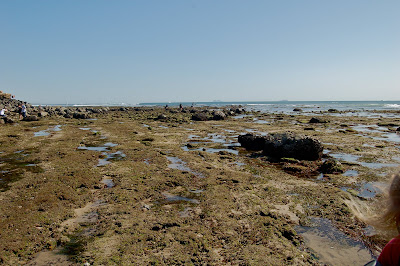Had SUCH an amazing weekend. Got a big, fat dose of the ocean and it's creatures. And fellow bio-enthusiasts.
Basically drove all day Friday and Monday, but Saturday and Sunday participated in the 20th year of rocky intertidal sampling at Cabrillo National Monument.
I've spent a LOT of time, mostly on the clock (tho' now I volunteer), in the rocky intertidal. On Sunday I saw TWO species I've NEVER seen there. Shocked and excited.
Here's the setting. Rocky intertidal zone, tide decidedly OUT. Doesn't immediately make you think WOW, a biological wonderland!
If you look v. close (and click on pic, of course) you can see the Coronado Islands, property of Mexico.
I like the above photo 'cause the flying blonde hair nicely demonstrates the afternoon wind that gradually gets faster and faster. With ocean-drippy pants and shoes, it can get a wee bit cold, but we lucked out with very nice, warm weather.
The low was only about -0.8 feet, but the high pressure (very sunny, dry day) really helped push the water out so I think the effective low was much better (at least -1.0).
Here's a lovely boulder sporting California mussels (Mytilus californianus), owl limpets (Lottia gigantia), aggregating anemone (Anthopleura elegantissima), thatched barnacles (Tetraclita rubescens), various algal species, plus many other things I can't see in this picture which are, nevertheless, tenaciously present.

Huge, old mussels, covered in thatched barnacles, acorn barnacles (Chthalamus spp.) and more. Awesome old brutes.

Knobby seastar (Pisaster giganteus). A pretty big one for this area, and the blue was fairly muted. I've seen some with more intense blue, but they are, nevertheless, pretty cool looking creatures.

Click on this to see the knobs more clearly. Interesting structures, and you can also see the little red thingies that look to me like the tiny finger-like projections in our intestines (villi) to increase surface area.
According to my genius marine biologist friend up at U Washington, Tacoma, Dr. Bonnie Becker, they are "Pedicellariae. Little pinchers on the surface." See http://en.wikipedia.org/wiki/Pedicellaria.
Best picture I EVER got of a giant keyhole limpet (Megathura crenulata). You can actually see the creature and his/her little face! Upside down, clinging to underside of intertidal rock; both rock and limpet festooned with algae.
The first of the two new-to-me species:
I believe this is a blind goby, Typhlogobius californiensis, but I have only found ONE picture on-line to confirm my on-the-spot guess, and that picture was from far, far away from San Diego. I do know someone from Scripps surveyed for them decades ago and found a lot, then another Scripps person (this a Ph.D. candidate) searched for same around the year 2000 and found close to, if not, none.
Anyhow, if I'm right, these creatures live comensally with ghost shrimp in burrows. Both species can tolerate very low dissolved oxygen. This is all stuff I learned through my contact with the aforementioned Scripps student.
Okay, I'm out of time, but next thing I'll post on this topic is a) the 2nd new-to-me species, and b) a photo quiz!
=)
biobabbler





No comments:
Post a Comment
Cool people write inside rectangles....